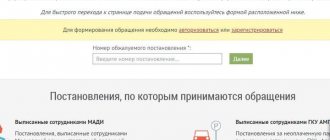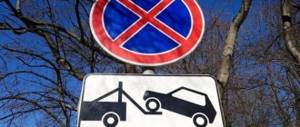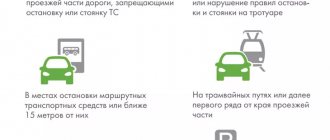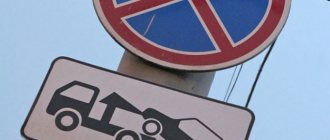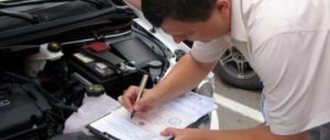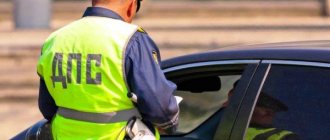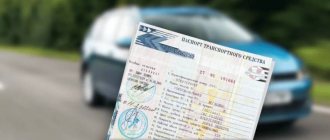When is a car towed, and when is it only a fine?
There are several cases when traffic rules violators are not only subject to fines, but also resort to other measures to suppress the violation. The vehicle of such a car owner will be detained and towed if the parking is carried out:
- four-wheeled (or more) vehicles in the second, third and subsequent rows;
- in the tunnel;
- on the road, provided that the gap from the car to the dividing strip is 3 meters or less;
- in the immediate vicinity of a pedestrian crossing (no more than 5 meters) or on it;
- at a distance of 15 meters or closer from the designated stop for buses, trolleybuses, taxis, if there are no parking spaces in this interval;
- under prohibitory signs, in the presence of a sign informing about the operation of a tow truck;
- where the vehicle blocked the entry/exit of other vehicles;
- on a site intended for disabled people;
- on the pedestrian sidewalk;
- on tram tracks or near them, provided that the car interferes with the movement of the tram;
The vehicle will also be towed if:
- lack of documents for the person driving the car;
- brake system malfunction;
- drug or toxic intoxication of the person driving the vehicle, or his refusal to undergo examination;
- non-compliance with the rules for the transportation of goods (dangerous and/or oversized).
The vehicle is not subject to detention if it is parked:
- under prohibitory signs in the absence of a sign indicating the operation of a tow truck;
- in a bicycle lane (not a path);
- in which the vehicle blocks a traffic light and/or road signs;
- in the immediate vicinity (no more than 5 meters) from or at the intersection;
- in close proximity (no more than 100 meters) to dangerous turns;
- in close proximity (no more than 50 meters) to or on a railway crossing;
- on the edge of the road, if there is a shoulder;
- across the road;
- on the left side of the roadway.
How to pick up a towed car from an impound lot for free: Video
Often, after a traffic accident occurs, a car is sent to a parking lot for various reasons. It will be necessary to pay an administrative fine and the time the car is placed in such a parking lot.
The procedure for seizing a vehicle itself has its own characteristics and nuances - you need to familiarize yourself with them in advance.
Today, the procedure for registering road traffic accidents has its own characteristics. Often, after an accident, the vehicle is towed to a special impound lot. It can be taken back if certain procedures are followed.
The following persons must be directly involved in the evacuation of the vehicle:
- traffic police officer – draws up a protocol and other documents required in this case;
- evacuation service worker - solves technical issues, loads the vehicle onto a tow truck and delivers it to the parking lot;
- an attesting witness is a random independent person who puts his signature on the protocol.
It is important to remember that the presence of the above list of persons is strictly required. For example, in the absence of an attesting witness who signs the protocol, the evacuation will simply be illegal.
The towing service is usually a third-party private organization with which the traffic police has an agreement for the transportation of vehicles that have violated traffic rules and in other cases.
The penalty parking itself is usually located on the territory of the traffic police. It must have a special department for returning cars to owners.
If no one comes for the car within a certain period of time, it can be sold to compensate for losses caused as a result of the accident.
There are a large number of different nuances associated with placing a vehicle in a impound lot and evacuation.
The question often arises: how to pick up a car from an impound lot after a fatal accident? This procedure has its own nuances. First of all, this concerns the list of documents required in a particular case.
It is important to remember that there is a limited list of situations when it is generally possible to seize a car for impound parking.
This issue is addressed in Art. No. 27.13 Code of Administrative Offenses of the Russian Federation. It reflects the following situations:
- for some reason the driver does not have the documents necessary to drive the vehicle;
- The following vehicle systems do not work:
- there is a drunken arrest;
- there is no appropriate permit for the transportation of dangerous goods;
- other.
It is worth familiarizing yourself with the full list of such violations in advance. This will allow you to avoid a large number of different troubles. And also protect your rights if they are violated.
Figuring out how to pick up a car from the impound lot after an accident with victims is quite simple. But first of all, you need to make sure that the car is towed legally.
Failure to do so will result in the right to proceed to trial in this regard.
In accordance with legal regulations, the first day of parking a vehicle in a impounded parking lot is free.
Subsequent ones will cost 40 rubles per hour. Subsequent ones - 60 rubles per hour.
It is worth familiarizing yourself with the prices in advance in order to prepare the necessary amount to pay for parking.
The algorithm for seizing a vehicle is as follows:
- eliminate the reason for the seizure of the car - fulfillment of this condition is basic (for example, go home to get your license or fix a malfunction of any vehicle systems);
- receive the vehicle detention report in hand - for this you will need to contact the relevant traffic police department and find the inspector responsible for this procedure;
- obtain the appropriate permission to receive a car and subsequently pay a fine, as well as parking in a fine parking lot - payment must be made within 30 days;
- After collecting all the documents necessary in this case, you can apply directly to the location of the vehicle.
You can return the vehicle at any time, at your own discretion. It is important to remember that if the fine is not paid, the car can also be taken away. You only need to pay for parking in a parking lot.
If for some reason, when all the conditions of the traffic police are met, they do not return the vehicle or require you to pay a fine in advance, this is a reason to go to court.
The list of documents required in this case includes the following:
- permission to issue documents;
- documents for the evacuated vehicle itself;
- driver license;
- passport of a citizen of the Russian Federation or other identity document;
- compulsory civil liability insurance policy;
- power of attorney for a car – if the vehicle is picked up from the parking lot not by the owner, but by his representative;
- all expenses are paid - the owner of the vehicle must be given a special receipt.
If for some reason a receipt is not issued, then this is a serious reason for going to court and the tax office. Since such penal parking lots are often used for money laundering. The tax office will definitely be interested in this.
It is important to remember that the cost of towing a vehicle in different regions of the Russian Federation is not the same. This issue is established by law, but at the local level. For example, in the capital, this issue is determined by Order No. 35-R dated 09.09.13.
We suggest you read: Is it possible to privatize with debts?
| category “A” and “B” (engine up to 80 hp) | 3 thousand rubles |
| category “B” (from 80 to 250 hp - excluding cargo) | 5 thousand rubles |
| category “B” (with an engine over 250 hp – except for trucks) | 7 thousand rubles |
| Category “D”, trucks, excluding oversized ones | 27 thousand rubles |
| category "A" | 500 rub. |
| category “B”, “D” (weighing no more than 3.5 tons) | 1 thousand rubles |
| category “D” (weight more than 3.5 tons), as well as “C”, “E” | 2 thousand rubles |
| oversized transport | 3 thousand rubles |
In accordance with current legislative norms, only a full day of placing a vehicle in the parking lot is subject to payment. But it is important to remember some nuances related to payment.
If possible, you should familiarize yourself with all prices in advance. This will allow you to avoid overpayment and protect your rights if necessary.
The cost of payment depends on a large number of different factors. First of all, this concerns the region where the evacuation took place. In this case, the region of registration of the vehicle does not matter.
Typically, the further from the capital the evacuation took place, the cheaper the parking will be.
Despite the fact that you do not need to pay a fine to pick up a vehicle from a parking lot, you will need to pay it later.
For example, when driving while intoxicated, the fine will be 30 thousand rubles, regardless of the region where such a violation was recorded.
There are a large number of different nuances associated with paying a fine. It will be possible to pay via the Internet, through an ATM, or a bank cash desk.
If possible, each car owner should familiarize himself with the rules for towing a vehicle.
The main rules today include the following:
- before evacuation, the traffic police inspector must draw up a special protocol (in two copies) - both the inspector himself and the owner of the vehicle must sign it (if the owner refuses to sign, then a corresponding entry is made);
- access points to the car must be sealed in a special way;
- storage of vehicles is regulated by the legislation of the Russian Federation;
- The storage period of the vehicle is counted from the moment the protocol is drawn up.
In some cases, you may not have to pay a parking ticket. But this is only possible if the vehicle is held for only 1 day. At the same time, you will need to pay for the fact of towing the vehicle.
Usually the cost of this procedure is at least 3 thousand rubles. Again, it all depends on the region of evacuation.
The algorithm for getting a car from a parking lot has its own characteristics and nuances. But it is standard.
As follows:
- a protocol is issued to the traffic police;
- All necessary documents are collected in this case;
- Payment is made for parking itself.
After completing all the above steps, the vehicle can be picked up from the impound lot.
The process of returning a vehicle usually does not cause any difficulties - if you make the payment and collect all the necessary documents. But it is much more profitable to simply avoid situations involving vehicle evacuation.
The towing service is usually a third-party private organization with which the traffic police has entered into an agreement for the transportation of vehicles that have violated traffic rules in other cases. The penalty parking itself is usually located on the territory of the traffic police. It must have a special department for returning cars to owners.
After completing all the above steps, the vehicle can be picked up from the impound lot. The process of returning the vehicle itself usually does not cause any difficulties - if you make the payment and collect all the necessary documents. But it is much more profitable to simply avoid situations involving vehicle evacuation.
The examination of the car frame number in the traffic police is discussed in the article: examination of the car frame number. For information on selling equipment from impound lots in Moscow, see the page. Find out the amount of the fine for losing your car number by clicking on the link.
What documents regulate the procedure for detaining a vehicle?
The rules for the detention and evacuation of vehicles are regulated by the Federal Law “On Road Traffic Safety”, as well as the Code of Administrative Offenses of the Russian Federation. Both of these documents were amended in 2015 and 2021, respectively.
The essence of the changes dated June 8, 2015:
- The detained vehicle is returned to a person who can drive it directly at the scene of the violation if the reason for the detention is eliminated. That is, if the car was parked incorrectly, but the driver managed to return before the car was taken away, the vehicle is returned to his disposal. But if the tow truck has already started moving, the car can only be picked up from the impound lot.
- An official (traffic police inspector) must remain at the place where the car was detained until it is evacuated. The amendment was adopted so that the driver, if he has time, can return his vehicle, because only the person who made the arrest can return the car to the owner.
- If the official does not comply with the owner’s request to return the vehicle to him before the tow truck starts moving (provided that he can drive it), he is subject to a fine of 20,000 rubles.
- Evacuation is provided for parking in a disabled spot.
- If there is no sign under the signs “Stopping and parking prohibited” or “Parking prohibited” indicating the operation of a tow truck, it is impossible to detain the vehicle.
The essence of the changes from September 1, 2021:
- Reimbursement for vehicle towing costs can be paid after the vehicle is collected from the impound lot.
- The owner or the person replacing him is required to provide a copy of the detention protocol, even if the protocol itself was drawn up without his participation.
- Tariffs for evacuation services and the presence of vehicles in impound lots are subject to state regulation.
At what stage of the adoption of the law on impound lots?
Article 2 of this Law just says that it has not yet entered into force. It was, of course, accepted and approved on 06/23/16 (signed by the President of the Russian Federation - V.V. Putin), however, it will only come into full legal force when it becomes active and legally valid on 09/01/16.
At the same time, today everyone is waiting to see how the evacuation of a car to a parking lot will happen in practice; whether the 2021 law provides for a more comfortable regulation of issues that often arise with parking lot employees or not.
But an undoubted benefit for motorists is already emerging - this is the opportunity to pick up your car from the impound lot before paying penalties for the offense.
Procedure for detention and evacuation
The procedure for detaining a vehicle is strictly regulated. In case of detection of traffic violations that entail evacuation, the law enforcement inspector must:
draw up a protocol indicating the date, exact time, article of the Code of Administrative Offenses of the Russian Federation on the basis of which the detention is carried out, the location of the offense, indicate information about the driver, information about the official who carried out the detention;
- provide a copy of the protocol to the driver;
- draw up a report in the presence of at least two witnesses, or by attaching a video of the car being detained if the driver is not there;
- seal the trunk and all doors to prevent unauthorized persons from entering;
- draw up an inventory of valuable property located in the car at the request of the owner;
- remain at the detention site until the tow truck starts moving.
After this, the car can only be picked up from the impound lot. If the inspector’s decision was unlawful, the requirement to pay for evacuation services can be appealed within 10 days.
Reasons for towing a car to an impound lot
According to Law 27.13 of the Code of Administrative Offenses, law enforcement officers have the right to pick up a car if:
- the driver drives a car without documents required by customs legislation or there are no registration documents on the car. According to Government Decree No. 1090, drivers are required to have a license, PTS or car registration documents, as well as compulsory motor liability insurance or another insurance policy when driving a vehicle. For this violation, the car will be towed to the impound lot and a fine will be imposed;
- the vehicle is operated with faulty brakes (“handbrake” is an exception), steering, or clutch device (in the case where the vehicle is part of a road train);
- the car is driven by a driver who does not have a license to do so (except for instructional driving with an instructor);
- the vehicle is driven by a driver whose license was previously revoked;
- the car is driven by a person who is drunk or intoxicated and without a license;
- the driver, leaving the vehicle, violated the rules regarding parking and stopping the car;
- the car caused a traffic jam, creating problems for the movement of other vehicles, due to parking or stopping at a pedestrian crossing, in the area where minibuses stop, on tram tracks;
- incorrect transportation of large or heavy loads is carried out; there are no documents that are required when transporting high-risk cargo;
- the driver refused to undergo a medical examination;
- after the accident, the driver used illegal drugs or alcohol; the vehicle was used as advertising or was converted for a specific product.
A car whose driver has violated any of these points is subject to transfer to a traffic police impound lot.
Register now and get a free consultation from Specialists
